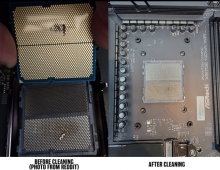
AMD 'Project Discovery' Tablet Coming In January
AMD plans to release the Mullins APU-based "Project Discovery" Windows 8 tablet in January.
The device, which has won a CES 2014 Innovation award, includes a game controller.
TechRadar.com got its hands on pictures of the unreleased tablet, the game controller and a docking station:

Judging from the pictures, the Project Discovery appears to use AMD's DockPort technology. It comes with a gamepad as well as the company's DockPort technoligy, which supports a number of peripherals, monitors and allowing charging through a single cable.
AMD has confirmed that the systems, which will be shown at CES in January. The device will most probably released by AMD's OEM partners, as the company does not plan to enter the market with a branded tablet and peripherals, at least for now.
The tablet will be powered by the Mullins APU SoC. As AMD confirmed earlier this week, Mullins will be built on the 28nm process and contain between 2 and 4 'Puma' CPU cores, GCN graphics, and an AMD ARM backed security processor. The SoC, with an approximate SDP of 2W will be a powerhouse within fanless mobile gadgets offering "up to 139 percent better productivity performance per watt" when compared to the previous generation 'Temash' platform.
TechRadar.com got its hands on pictures of the unreleased tablet, the game controller and a docking station:

Judging from the pictures, the Project Discovery appears to use AMD's DockPort technology. It comes with a gamepad as well as the company's DockPort technoligy, which supports a number of peripherals, monitors and allowing charging through a single cable.
AMD has confirmed that the systems, which will be shown at CES in January. The device will most probably released by AMD's OEM partners, as the company does not plan to enter the market with a branded tablet and peripherals, at least for now.
The tablet will be powered by the Mullins APU SoC. As AMD confirmed earlier this week, Mullins will be built on the 28nm process and contain between 2 and 4 'Puma' CPU cores, GCN graphics, and an AMD ARM backed security processor. The SoC, with an approximate SDP of 2W will be a powerhouse within fanless mobile gadgets offering "up to 139 percent better productivity performance per watt" when compared to the previous generation 'Temash' platform.




















